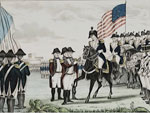Decisive Battles in the War of Independence
Question

What were the most important battles of the American Revolution?
Answer
Historians count the Saratoga and Yorktown campaigns as among the most consequential in the American War of Independence. The Saratoga campaign began in the summer of 1777, when more than 8,000 British troops under the command of General John Burgoyne began marching from Quebec to Albany, NY. Their ultimate aim was to control the routes across the Hudson River, isolating New England—hotbed of the rebellion—in the process.
Encumbered by an unusually large baggage train and by 138 artillery pieces, Burgoyne’s progress was slow, and he repeatedly delayed while awaiting the delivery of supplies. American forces under Henry Gates harassed the British force as it made its way south. Finally, in a series of battles fought in September and October 1777, the campaign came to a climax as British troops attacked fortified positions around Saratoga, NY. American forces (rallied at one point by patriot General Benedict Arnold, who had not yet defected to the British) inflicted heavy casualties on their opponents.
Four years later, the 1781 Yorktown campaign helped seal the American triumph in the war. British commander Charles Cornwallis, believing that victory in Virginia would end the rebellion in Georgia and the Carolinas, marched a detachment of troops to Yorktown, hoping to establish a British naval base on the Chesapeake. Sensing an opportunity to trap the British, General George Washington and the allied French commander Rochambeau marched their forces south from New York in late August, and on September 14 arrived at Yorktown. Discovering the British position too well entrenched to attack, the Patriots established a siege intended to force the British to capitulate.
The Americans’ two-to-one numerical advantage ultimately proved insurmountable. Outnumbered, the British withdrew to inner lines of fortifications as the Patriots consolidated their position. With French warships blocking the British in the York River to the north, Washington’s troops dug trenches parallel to the British lines, and brought up their own cannon to bombard the opposing position. On October 14, Patriot forces stormed the British lines east of the town, enabling them to direct a withering fire against the main British defenses. Five days later, acknowledging the futility of his position, Cornwallis surrendered his command. At a loss of only six dozen killed, the Americans had won a major victory against one of the world’s most powerful military forces.
Though significant victories, neither the battle at Saratoga or at Yorktown was in itself decisive. The British continued to mount a serious war effort in the colonies for years following the defeat at Saratoga, threatening the Patriot cause with defeat numerous times. The defeat at Yorktown, often seen as the culminating battle of the war, did not end the conflict: localized fighting continued for another year and a half, and even the formal surrender did not signal the end of British military power globally. Indeed, even as Cornwallis’s men stacked their arms at Yorktown, a powerful British force under Sir Henry Clinton sailed from New York to Virginia. The British retained their formidable military might, but following the surrender at Yorktown determined that continued efforts to subdue the colonists were futile.
The fact that even the surrender at Yorktown did not end Britain’s ability to wage war speaks to the nature of the War of Independence. Scholars often term that kind of struggle, in which the two belligerents pursue different strategies in order to realize different kinds of goals, as “asymmetrical”. Winning their war required the British to restore loyalty throughout the colonies, a goal that placed heavy demands on their forces. British troops had to conquer large swaths of territory, pacify a population that was indifferent or outright hostile to crown rule, and garrison the territory they occupied to ensure it did not return to Patriot control. British armies had to control the massive territorial expanse of the colonies and subdue Patriot strongholds in major cities like Boston and New York in order to overcome the rebellion.
The Patriot side pursued a very different strategy, in accordance with a different set of goals. No one imagined that Washington’s forces needed to cross the Atlantic and capture London in order to secure their victory. Rather, the Patriots could hope to win the war simply by forcing a protracted struggle that forced the British to devote increasing amounts of time, money, and troops to their war effort. The colonists could thus make war on British will, rather than on their armies: in essence, the Patriot side could win the war simply by not losing it, and waiting for the British to tire. Victories at crucial junctures like Saratoga and Yorktown helped the Patriots extend the war so long that the British no longer perceived the continued effort and expense to be justified.
For more information
Higginbotham, Don. The War of American Independence. New York: Macmillan, 1973.
Royster, Charles. A Revolutionary People At War: The Continental Army and American Character, 1775-1783. Chapel Hill: University of North Carolina Press, 1980.
